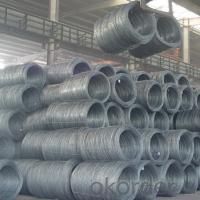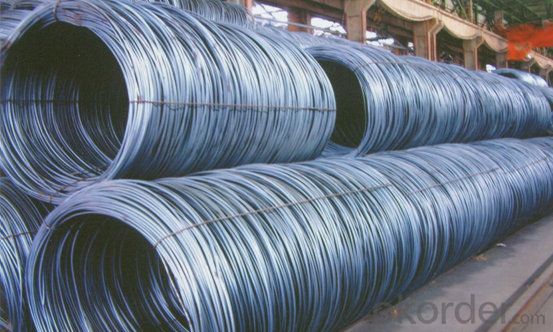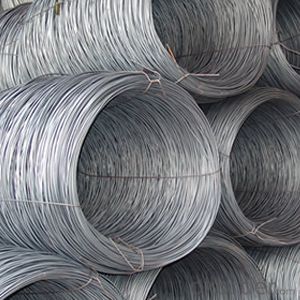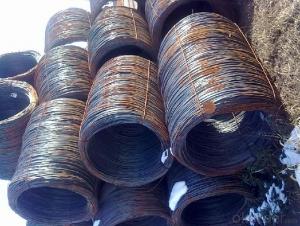hot rolled wire rod for construction GB Q235
- Loading Port:
- Tianjin
- Payment Terms:
- TT OR LC
- Min Order Qty:
- 25 m.t.
- Supply Capability:
- 100000 m.t./month
OKorder Service Pledge
OKorder Financial Service
You Might Also Like
Product Description:
Specifications of Hot Rolled Wire Rod:
Steel Grade: Q195/235, SAE1006-1018B Standard: ASTM, GB
Diameter: 5.5mm, 6.5mm, 7mm,8mm,9mm,10mm,12mm,14mm
Type: in coil, coil weight around 2MT Alloy or Not: Alloy
Technique: Hot Rolled Place of Origin: China Mainland
Surface: round, no twisted, light and smooth Brand Name: HSKY
Chemical Composition: (Please kindly find our chemistry of our material based on Q195、Q235A and Q235B as below for your information)
| Trademark | Rank | Chemical composition (quality score) % | ||||
| C | Si | Mn | S | P | ||
| ≤ | ≤ | ≤ | ||||
| Q195 | 0.06-0.12 | 0.30 | 0.25 | 0.050 | 0.045 | |
| Q235 | A | 0.14-0.22 | 0.30 | 0.30-0.65 | 0.050 | 0.045 |
| Q235 | B | 0.12-0.20 | 0.30 | 0.30-0.70 | 0.045 | 0.045 |
Usage and Applications of Hot Rolled Wire Rod:
After hot-rolled the products shaped into coil and delivery as finished product, including round, square, rectangular, hexagonal and so on. Since most of the products are round, it is generally called wire rod. Carbon steel wire rod is widely used in construction and manufacturing. Carbon steel wire rod is mainly used for reinforcement of reinforced concrete and welded structure or reprocessed (roberts , nail, etc.) materials, especially used to produce wire drawing, welding electrode, nails, spring, electronic, precise machinery parts and so on.
Packaging & Delivery of Hot Rolled Wire Rod:
Packaging Detail: products are packed in coil, each coil weight around 2 MT, and then shipped by container or bulk vessel
Delivery Detail: within 45 days after received deposit or LC.
Label: to be specified by customer, generally, each bundle has 1-2 labels
Trade terms: FOB, CFR, CIF
Hot Rolled Wire Rod in Container



Note:
1. Our products are produced according to national standard (GB), if not, supply according to national standards (GB) or agreement as customer required.
2. Other Grade and Standard carbon steel wire rod we can supply:
Grade: H08A, 30MnSi, 62B-82B
Standard: AISI, BS, JIS, DIN
The Minimum Order Quantity of these products is high, and need to be confirmed.
3. We can not only supply carbon steel wire rod; if you need anything about building materials, please contact us.
4. Please send us your detail specifications when inquire. We will reply to you as soon as possible. We sincerely hope we can establish a long stable business relationship
- Q:How is steel wire rod used in the manufacturing of wire for musical instrument strings?
- Steel wire rod is a crucial raw material used in the manufacturing of wire for musical instrument strings. It is first drawn through a series of dies to achieve the desired diameter and shape. This process ensures that the wire is strong, durable, and has the necessary flexibility to produce the desired musical tones. The wire is then further processed, coated, and wound onto specific cores to create strings for various musical instruments, such as guitars, pianos, violins, and cellos. The quality and properties of the steel wire rod directly impact the sound quality, longevity, and performance of the instrument strings.
- Q:What is the difference between hot rolled and cold drawn steel wire rod?
- Hot rolled and cold drawn steel wire rods are both used in various industries for different applications. The main difference between the two lies in the manufacturing process. Hot rolled steel wire rod is produced by heating a billet or ingot to a high temperature and then rolling it through a series of rollers to achieve the desired shape and dimensions. This process results in a larger diameter and a rougher surface finish. Hot rolled steel wire rods are commonly used in construction, automotive, and machinery applications where strength and durability are important. They are also more cost-effective than cold drawn wire rods. On the other hand, cold drawn steel wire rod is produced by pulling the hot rolled wire rod through a series of dies at room temperature. This process results in a smaller diameter and a smoother surface finish compared to hot rolled wire rods. Cold drawn wire rods are commonly used in applications where precision and a smooth surface finish are required, such as in the manufacturing of precision components, automotive parts, and electrical conductors. In summary, the main difference between hot rolled and cold drawn steel wire rods is the manufacturing process, which affects the diameter, surface finish, and application suitability. Hot rolled wire rods are larger in diameter with a rougher surface finish, while cold drawn wire rods are smaller in diameter with a smoother surface finish. The choice between the two depends on the specific requirements of the application in terms of strength, precision, and surface finish.
- Q:How is steel wire rod used in the manufacturing of wire partitions?
- Steel wire rod is used in the manufacturing of wire partitions by being processed through various stages including drawing, annealing, and coating to form strong and durable wires. These wires are then woven or welded together to create the framework of wire partitions, providing stability and security.
- Q:What is the composition of a steel wire rod?
- A steel wire rod is primarily composed of iron, with additional elements such as carbon, manganese, silicon, and sometimes small amounts of other elements to improve its strength and other properties.
- Q:How is the competitive landscape of the steel wire rod market?
- The competitive landscape of the steel wire rod market is highly dynamic and competitive. This market is characterized by the presence of various large and small players, both domestic and international, who are constantly striving to gain a greater market share. One of the key factors contributing to the competitiveness in this market is the high demand for steel wire rods, which are widely used in various industries such as automotive, construction, and manufacturing. As a result, companies are continuously innovating and investing in research and development to improve the quality and performance of their steel wire rods, in order to meet the evolving needs of customers. In addition, the steel wire rod market is also affected by various external factors such as fluctuations in raw material prices, government regulations, and global economic conditions. Companies must navigate these challenges and develop effective strategies to stay competitive in the market. Furthermore, mergers and acquisitions are common in this industry, as companies seek to expand their market presence and enhance their product offerings. This leads to further consolidation and intensifies the competition among players. Overall, the competitive landscape of the steel wire rod market is characterized by intense rivalry, technological advancements, and strategic collaborations. Companies must continuously adapt and differentiate themselves to maintain a competitive edge in this dynamic market.
- Q:What are the main steel wire rod import and export markets?
- Depending on the country and region, the main markets for importing and exporting steel wire rod vary. However, China, the United States, Japan, Germany, South Korea, and Russia are key players in the global steel wire rod trade. China, being the largest producer and consumer of steel wire rod, has a significant presence in the export market. It exports steel wire rod to various destinations, including Southeast Asian countries, the United States, and Europe. The United States is also a major player in the steel wire rod market. It imports substantial amounts of steel wire rod from Canada, Mexico, and Brazil. Additionally, the United States exports steel wire rod to Canada and Mexico. Japan, known for its high-quality steel products, both imports and exports steel wire rod. It primarily imports steel wire rod from South Korea, China, and Taiwan, while its main export destinations include Southeast Asian countries and the United States. Germany is a significant market for steel wire rod in Europe. It mainly imports steel wire rod from Russia, Turkey, and Ukraine. Germany also exports steel wire rod to neighboring European countries. South Korea is a major exporter of steel wire rod, primarily to Vietnam, Malaysia, and the United States. It also imports steel wire rod from China, Japan, and Russia. Lastly, Russia plays an important role in the steel wire rod market as both an exporter and importer. It exports steel wire rod to various countries, including Germany, Italy, and Turkey. Russia also imports steel wire rod from South Korea and China. In conclusion, these countries dominate the global steel wire rod import and export markets, each with its own unique position and trade partnerships. However, it is important to note that the steel industry is dynamic, and market conditions can change over time, affecting import and export dynamics.
- Q:What are the different corrosion testing methods for steel wire rod?
- There are several corrosion testing methods for steel wire rod, including salt spray testing, exposure testing in natural environments, electrochemical testing, and accelerated corrosion testing using corrosive liquids or gases. These methods help assess the corrosion resistance and durability of the steel wire rod in various conditions.
- Q:What are the different types of steel wire rod surface treatments after wire drawing?
- There are several types of steel wire rod surface treatments after wire drawing, including galvanizing, zinc coating, phosphating, and powder coating. These treatments are applied to enhance the wire's corrosion resistance, increase durability, and improve its appearance.
- Q:What are the common production processes for radon-coated steel wire rod?
- The common production processes for radon-coated steel wire rod typically involve a series of steps. First, the steel wire rod is cleaned and prepared to remove any impurities. Then, it goes through a coating process where it is treated with radon, a radioactive gas, to create a thin layer on the surface of the wire rod. This coating is important as it helps improve the wire rod's resistance to corrosion and increases its durability. Finally, the coated wire rod is inspected for quality and packaged for distribution or further processing.
- Q:What are the transportation options for steel wire rod?
- The transportation options for steel wire rod typically include trucking, rail transport, and sometimes even shipping by sea or air for long-distance or international deliveries.
1. Manufacturer Overview |
|
|---|---|
| Location | |
| Year Established | |
| Annual Output Value | |
| Main Markets | |
| Company Certifications | |
2. Manufacturer Certificates |
|
|---|---|
| a) Certification Name | |
| Range | |
| Reference | |
| Validity Period | |
3. Manufacturer Capability |
|
|---|---|
| a)Trade Capacity | |
| Nearest Port | |
| Export Percentage | |
| No.of Employees in Trade Department | |
| Language Spoken: | |
| b)Factory Information | |
| Factory Size: | |
| No. of Production Lines | |
| Contract Manufacturing | |
| Product Price Range | |
Send your message to us
hot rolled wire rod for construction GB Q235
- Loading Port:
- Tianjin
- Payment Terms:
- TT OR LC
- Min Order Qty:
- 25 m.t.
- Supply Capability:
- 100000 m.t./month
OKorder Service Pledge
OKorder Financial Service
Similar products
New products
Hot products
Hot Searches
Related keywords



























